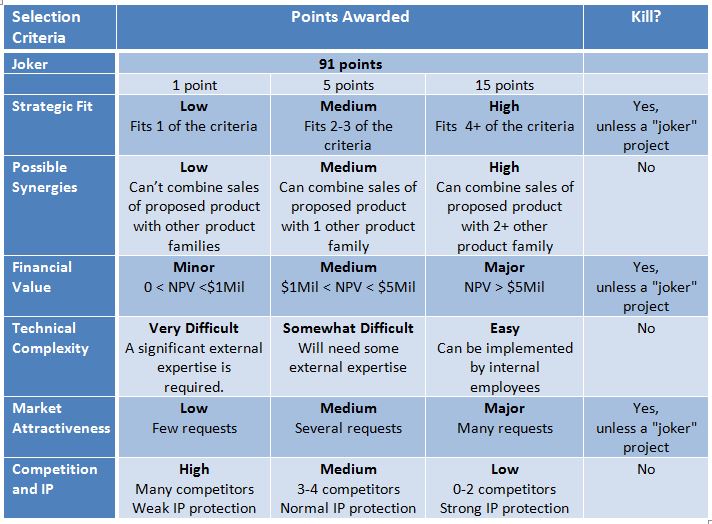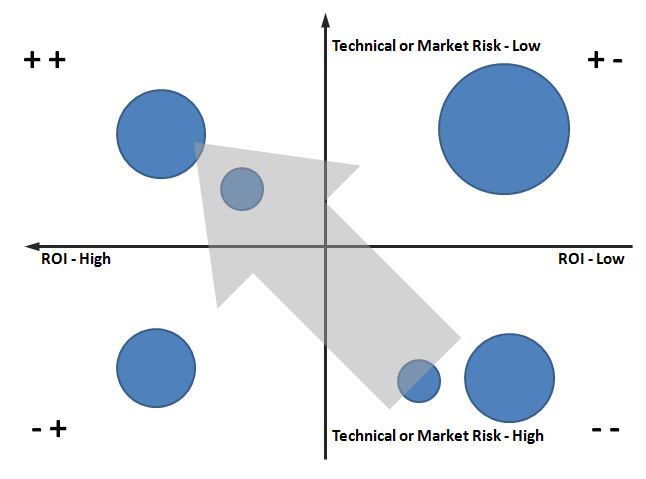Introduction
In my professional engagements I very frequently get to develop project portfolio management models together with the executives from various companies. Today I wanted to share yet another very interesting case study with my readers: the company we are going to examine is a very successful bearings manufacturer. As a matter of fact for a number of years they have focused all of their research and development efforts solely on the bearings production.
However, under a considerable pressure from their sales team, the executives of the company has at one point of time decided to review their strategy. The sales department has been for several years insisting that when they talk to their customers, they keep asking questions about other bearing-related products such as sealants, lubricants and electronic components which the company has not been producing at the time.
Strategy
As a result of the above-mentioned events the company management came up with the new strategy for the R&D department that consisted of the following initiatives:
- Develop new (i.e. lubricants, sealants and electronic components) product families
- Develop attractive products (i.e. something that is really demanded by our customers)
- Increase revenues and profitability by developing new product families
- Increase market share in the new markets
The Scoring Model
The scoring model developed by the executives included the following variables (see Table 1):
- Strategic fit
- Possible synergies
- Financial value
- Payback
- Technical complexity (skills in-house)
- Market attractiveness
- Competition and IP
Table 1
Unsurprisingly the first variable added to the prioritization matrix was the strategic alignment. If the project proposal fit one of the strategic criteria, it would receive one point, if the proposal covered two or three of the strategies - five points, and, finally fifteen points if it addressed four or more of the strategic criteria. In addition, this variable has been designated as a "kill' category. In other words, if the proposed venture did not address any of the strategic criteria it automatically became a candidate for dismissal, unless awarded a "joker" status by the senior management.
The points for the next variable - possible synergies - have been distributed in the following manner:
- Can’t combine sales of proposed product with other product families - 1 point
- Can combine sales of proposed product with 1 other product family - 5 points
- Can combine sales of proposed product with 2+ other product family - 15 points
The executives felt strongly that in order for the company to maintain its competitive position in the market they needed to add a variable that accounted for the financial gains to be realized from the new products. After much consideration the management chose net present value as the third variable to be added to the matrix. The project would receive one point for NPV less than one million, five points for NPV between one and five million dollars, and fifteen points for NPV exceeding five million dollars. This category was deemed to be a "kill" variable with the proposals where NPV was less than zero requiring special C-level approval.
The management also felt that the technical complexity of the proposed ventures should also be considered as the company was planning to move into the new technologies, including lubricants, sealants and electronic components. As a result they added this variable to the model with the following parameters:
- A significant external expertise is required - 1 point
- Will need some external expertise - 5 points
- Can be implemented by internal employees - 15 points
Considering the fact that it was the sales team who initiated the aforementioned transformation at the R&D department, the executives added the market attractiveness variable to the mix in order to gauge the potential sales of the product. The sales executives proposed to measure this category in terms of customer requests for a specific product type. As a result the products that received only a few inquiries would get one point, the ones with several requests - five points and the ones receiving a lot of inquiries from the clients - fifteen points. In addition this variable has also been designated as a "kill" category for the products receiving very few or no requests at all.
Finally, the management decided to include the competition and intellectual protection category in order to ensure that the new products are unique and could be protected by patents. The points have been distributed in the following way:
- Many competitors and weak IP protection - 1 point
- 3-4 competitors and normal IP protection - 5 points
- 0-2 competitors and strong IP protection - 15 points
As a result, the project candidate could generate a maximum of ninety points and a minimum of six points - unless it scored zero in one of the "kill" categories - in the proposed model.
Portfolio Balance
The executive team has indicated that they would be interested in analyzing their portfolio from the market or technical Risk vs. Reward balance perspective (see Figure 1):
Project Balance
- Market or Technical Risk vs. Reward
Figure 1
Strategic Alignment
Considering the situation and the new strategy of the company's R&D department, the management decided to designate the following resource buckets for its upcoming projects:
- 10% - Bearings,
- 30%- Sealants,
- 30% - Lubricants,
- 30% - Electronic Components
In addition the company has adopted the "top-down, bottom-up" approach for all project proposals.
About the Author
Jamal Moustafaev, MBA, PMP – president and founder of Thinktank Consulting is an internationally acclaimed expert and speaker in the areas of project/portfolio management, scope definition, process improvement and corporate training. Jamal Moustafaev has done work for private-sector companies and government organizations in Canada, US, Asia, Europe and Middle East. Read Jamal’s Blog @ www.thinktankconsulting.ca
- Please follow me on Twitter:
- Like our page on Facebook:
- Connect with me on LinkedIn:
- Subscribe to my RSS feed:
Jamal is an author of two very popular books: Delivering Exceptional Project Results: A Practical Guide to Project Selection, Scoping, Estimation and Management and Project Scope Management: A Practical Guide to Requirements for Engineering, Product, Construction, IT and Enterprise Projects.


